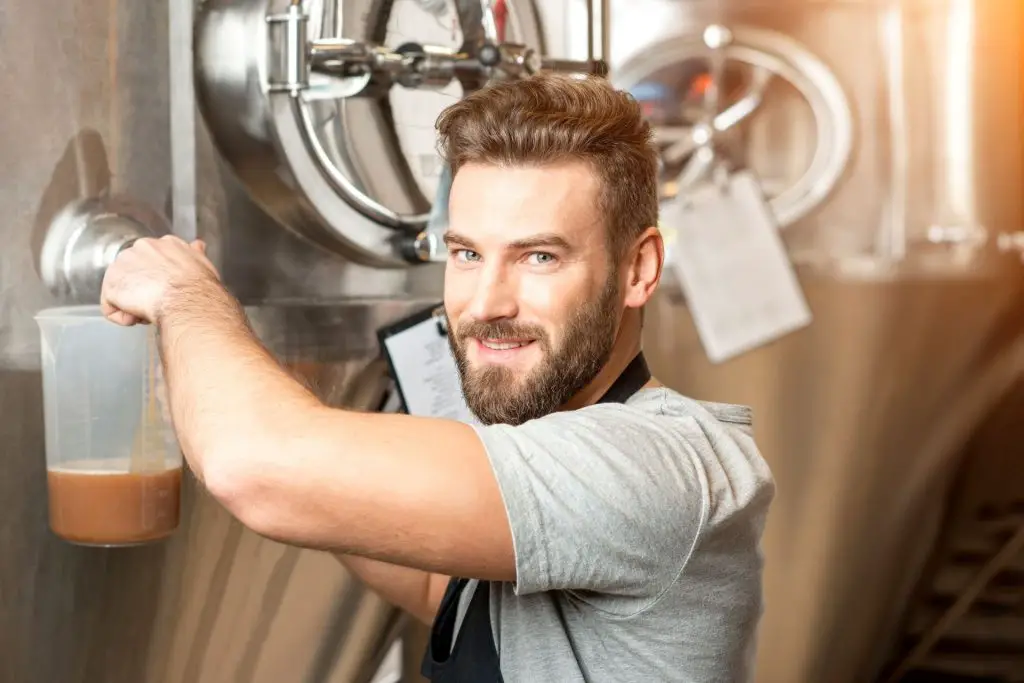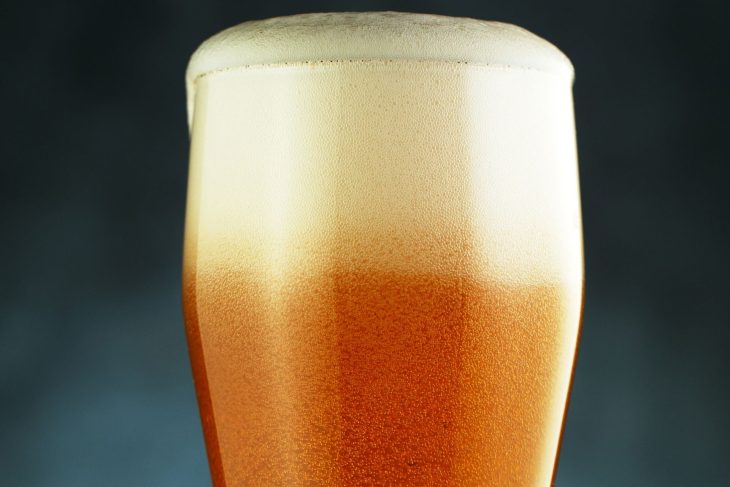Hey there! This site is reader-supported and we earn commissions if you purchase products from retailers after clicking on a link from our site.

Now that you have been home brewing your beer for a while, you may be looking for a new way to try out all those techniques you have picked up. One way to test your mettle is to try first wort hopping (FWH). Imagine saving time and mess when boiling your wort and squeezing all those delicious oils from the hops simultaneously. Sounds great, right?
First wort hopping is still considered theoretical in the homebrew beer world, but it does have some benefits involved. If you want to limit boil over, then you have more than enough reasons to give FWH a try.
But what else separates first wort hopping from other methods? Keep reading to find out!
What is First Wort Hopping?
Does trying out new brewing techniques make you nervous? Don’t worry if it does. We all go through the jitters. No one wants to ruin their beer, after all. That happens to be the first reason you should give first wort hopping, or FWH, a try. Not only is the process easy, but the effect on the overall flavor is not that dramatic. You will potentially taste a difference, but it won’t be too great a change.
Basically, first wort hopping is when you add hops before the boil, not during. You add a small portion of hops to the brew kettle as the wort heats to a boil. Then, you leave those hops in the wort throughout the whole boil. Some people will nix any later hop additions, but you can experiment. It depends on the hops you choose, but we’ll get into that in a moment.
Keep in mind that first wort hopping is not the same as “mash hopping.” The latter is a process that involves adding hops to the mash tun while it rests. Hops added to a mash tun do not undergo the same chemical changes as those used in FWH.
Who Discovered First Wort Hopping?
FWH may have been discovered by accident. Maybe a brewer wanted to try something new—or maybe they forget what step they were on—and decided to toss some hops into their brew kettle before boiling. Then they tasted the end result and found that there were new flavors in the beer.
It’s difficult to say who first discovered FWH, but it was definitely a common practice for brewers at the beginning of the 20th century. Brewers back then didn’t want to waste a single hop. Then, around the middle of the 20th century, first wort hopping went out of style. Then, in 1995, a German magazine called Brauwelt International had an article talking about the “rediscovery of first wort hopping.”
They reported on a study that was done on first wort hopping while brewing up a pilsner that concluded with a finer aroma. Two large production breweries took part in the study by producing two pilsners using similar yeast pitching rates, malt lots, Type 45 pellets, and brewing water.
The researchers tested the beers on a couple of panelists, and the end result was optimistic. The panelists stated that the beers made with first wort hopping were far more pleasant and harmonic.
The Science of First Wort Hopping

So, having already mentioned the Brauwelt experiment, you may already have some idea as to how and why first wort hopping could be effective. If not, don’t worry. We’re going to explain the chemistry to you.
Hops can be split into two parts: the alpha acids and the oils. Adding hops at the beginning of the boil will increase the alpha acids, while the oils are boiled off. When you add hops before the boil as the water heats, the oils are much more soluble. This means the oils will diffuse into the wort and linger, keeping the hop aroma long enough for you to taste it.
And that harmonious bitterness we mentioned? The exact science behind how that happens is not exactly known, but it is believed that the alpha acids found in hops are a clue. One of the alpha acids, cohumulone, is extremely bitter. First wort hopping limits the amount of cohumulone in beer. It is believed that the lower pH of the wort contributes to a more balanced bitterness.
Is First Wort Hopping Effective?
Why should you try first wort hopping, you ask? Even if you don’t believe that FWH can make your beer any tastier than it already is, there is another reason we think it’s worthwhile. First wort hopping reduces the amount of mess. Besides, it’s easy to incorporate.
If the hiss of boil-over haunts you when you sleep, or if you are still traumatized from the mess, we understand. And that is why first wort hopping is great.
See, boil-over happens when there is a phase change—as liquid changes to vapor. In other words, when you drop hops into boiling water, all those oils and acids and proteins are going to be denatured and agitated. If you pour the hops in too quickly, the reaction is going to be a sticky wort volcano.
With first wort hopping, the hops do not agitate the phase change. Instead, they are heated up alongside the wort, so the oils, acids, and proteins have already disbursed into the liquid. Even if you do FWH then add some hops later for flavor, the chances of boil-over are greatly reduced.
How to First Wort Hop
Doing a first wort hopping is incredibly easy. You might be surprised to find that you don’t need any extra equipment. You just need a minor tweak to the whole brewing process—and you’re not even adding on that much time.
Which Hops Should I Use For FWH?
Traditionally, brewers would use the aroma hops for the first wort hopping. In other methods, the aroma hops are added last, because the oils boil off rapidly. If you add them too early to boiling water, you lose their flavors and aroma. With FWH, the oils dissolve into the wort and are retained.
That said, you can just as easily use your bittering hops in the beginning. Some experiments with FWH, including one done at Oregon State University’s Oregon Brew Lab, used the bittering hops for FWH. However, those studies also found that using bitter hops for first wort hopping results in little to no difference in the overall flavor of the beer. The Brauwelt study, on the other hand, added the aromatic hops first.
So, it’s up to you. If you would rather do first wort hopping to limit boil-over, you can go either way. Looking for a greater aroma and balanced bitterness? Go with the aroma hops for FWH.
When to First Wort Hop

If you want to try the FWH process, then you will have to start after boiling the grains but before you lauter the wort. Remember, you cannot do first wort hopping when brewing with extracts. This only works if you are doing all grain brewing.
If that sounds like total gibberish to you, don’t worry. Lautering is what happens when you separate grains from your wort.
First Wort Hop Instructions
To try FWH, do the following:
- Add your hops to the empty brewing kettle. The portion is substantial—about 30-50% of the entire hop bill for the recipe. These hops will remain in the wort for the entire boiling duration.
- Meanwhile, heat your wort to around 76ºC (170ºF) then lauter it. Transfer the lautered wort to your brew kettle. The temperature at this point is crucial to your FWH success. You want the liquid to be warm so that the essential oils within the hops are activated instead of evaporating rapidly.
- Continue heating the wort to a boil as you normally would. Process on with your regular brewing process.
See? Easy-peasy! There is no reason why you should give first wort hopping a try, because it really adds no extra steps to the all grain brewing process. If you want a faster cleanup, grab a hop spider.
Also, if you want to do first wort hopping successfully, schedule your low alpha acid hops for later, as they will be better for the final flavor and aroma additions. Keep in mind that the more hops you add during the initial boil, the more the bitterness increases.
Final Thoughts on First Wort Hopping
Although the science is scarce and often has contradictory results, it is worth giving first wort hopping a try. Since it is easy to do on your own, you can do a few test runs and see if there is any difference in your home-brewed beer. The worst case scenario is that you do a bit less work than usual and get beer that tastes as it should. Nothing wrong with that, right?
Recommended Reading
Sweet Beers: Your Ultimate Guide to Drinking and Brewing Sweet Beers
If you are looking for more information on sweet beers, this Ultimate Guide to Sweet Beer will tell you everything you need to know and more.
Here’s For The Geeks: Honningbrew Mead Recipe
If you are on the quest for a delicious mead, then here is one you have to know: Honningbrew Mead. The gamers already know about it. Honningbrew mead is a recipe designed from an expensive mead found in the game The Elder Scrolls V: Skyrim.
How to Batch Sparge For Maximum Brewing Efficiency
You started out with brewing beer from extracts. Then you tried all grain brewing and brewing in a bag. What’s next on the challenge list? Batch sparge brewing may become your new favorite process once you give it a try.
What is the Best Brewing Sanitizer?
One of the things you need to know before you even pick up your first homebrewing recipe is which brewing sanitizer is the best.
How to Use and Read a Hydrometer
Knowing how to read a hydrometer will come in handy. This guide will help you master the art of using a hydrometer when brewing up beer, mead, wine, or something else.
Extract Brewing Guide for Beginners
There are no shortcuts to great beer. You might think that using malt extracts for homebrewing makes you look like a rookie (even if you are just starting out), but you’d be mistaken.
